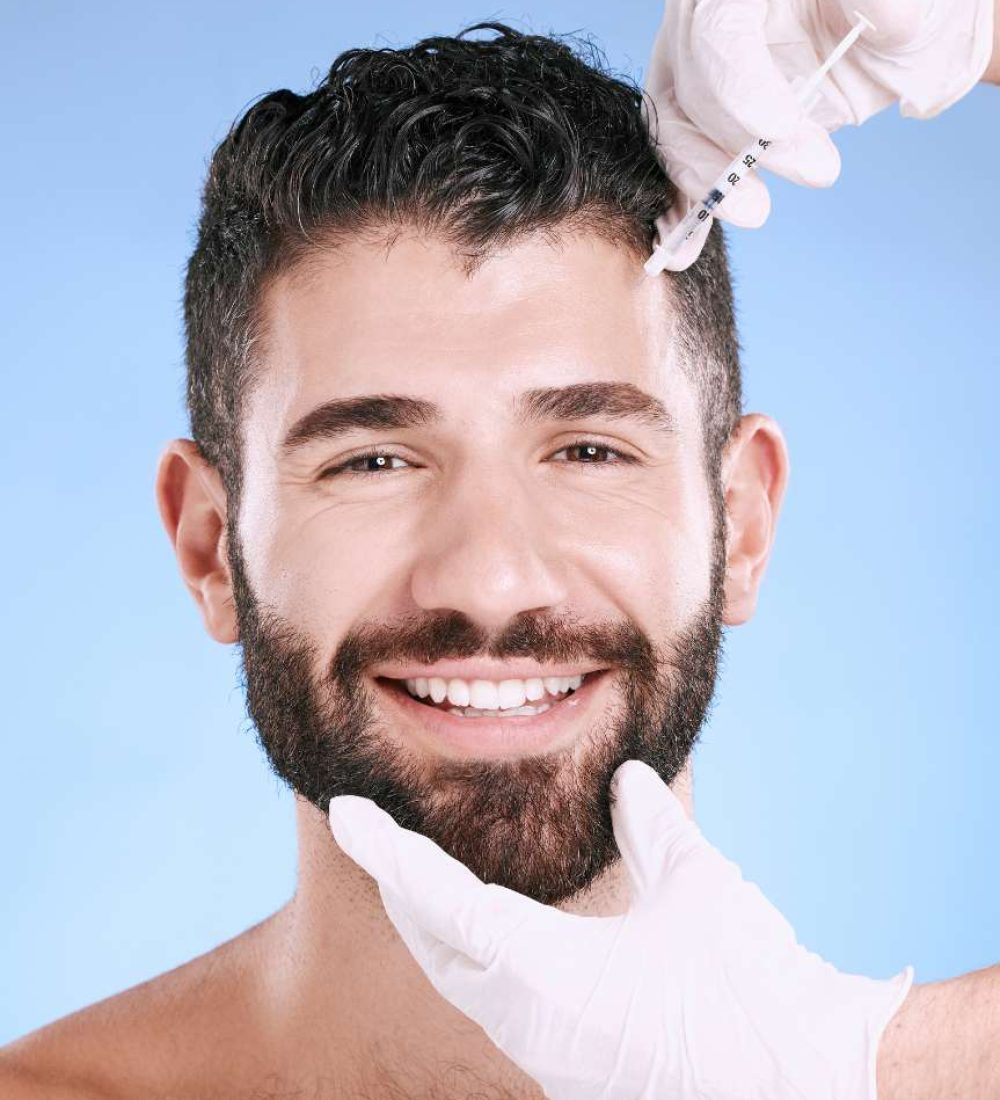Centrally located in Southampton, PA and serving Philadelphia, Bucks, and Montgomery Counties, The Kole Plastic Surgery Center performs facelifts for men desiring plastic surgery.
Facelift procedures specifically designed for men can be an effective way to minimize the unwanted effects produced by aging, life stresses, and chronic sun exposure.
Although the results achieved with male facelift surgery are similar to those enjoyed by women, male facelift patients should be aware of differences in the goals and surgical approaches for men. Many men seeking facelift procedures are less concerned about removing wrinkles and more interested in restoring the angular planes of the youthful male face, especially in the jawline, chin, and neck.


Generally, healthy men who would like to enhance their facial appearance make good candidates for a male facelift surgical procedure. The facelift procedure is specifically designed to minimize the effects of time and the effects of gravity commonly faced by men. These common aging effects include sagging of the cheeks and loose skin around the neck and jawline. These lines form a heavy aged appearance that is undesirable to most men.
As with all male cosmetic surgery, you are most likely to be satisfied with your results if you maintain realistic expectations for your facelift operation. It is not possible to stop or reverse aging. What can be done is to repair some of the damage to your appearance caused by the aging process.
No facelift procedure corrects the signs of aging in the upper face, such as crows’ feet or forehead wrinkles. It is for this reason that a facelift is often combined with other procedures—such as a forehead lift or Botox® cosmetic injections—for total facial rejuvenation.
The surgical approach for male facelift patients is generally the same as that for a facelift for women. In both approaches, the patient seeks a younger and more energetic appearance. The overall surgical preoperative planning and strategy for achieving these results is also similar. This involves the removal of excess facial fat and redundant skin, along with the remodeling of lax muscles and tissues below the skin’s surface.
However, a facelift procedure for men does involve the use of slightly different surgical techniques than in women. Perhaps the key difference between the procedure for men and women involves the incisions made during surgery. Because men tend to wear their hair shorter than women do, hiding the scars after a male facelift procedure is more difficult. This often allows for significantly less flexibility in terms of incision placement. However, the incisions are always placed as inconspicuously as possible, usually along the natural crease where the ear meets the cheek, around the natural fold of the earlobe, and into the lower scalp area under the sideburn hair.
A successful facelift procedure can make men feel younger and more handsome than they have in years. Looking and feeling better often leads to increased confidence levels and a positive attitude change others will notice.
The price of a male facelift varies for each person. The cost depends on the extent of surgery necessary to achieve your individual appearance goal.
The Kole Plastic Surgery Center Center accepts cash, check, and credit card (MasterCard®, Visa®, American Express®, Discover®) as acceptable forms of payment.
Financing is also available through CareCredit®, United Medical Credit and Advanced Care.
For other Frequently Asked Questions regarding Male Facelift visit our FAQ page


Male FaceliftMale Tummy TuckMale Eyelid SurgeryMale Breast Reduction
Facelift surgery helps with the most severe signs of aging, such as deep wrinkles, creases and folds. Although it is one of the more traditional cosmetic facial surgeries, few surgeons understand how to tailor the techniques to achieve a masculine and youthful appearance. Board certified plastic surgeon, Dr. Kole has the expertise and experience that you need to look younger and masculine with facelift surgery. To learn more about male facelift techniques for men in Southampton, PA, Philadelphia County, Bucks County, Montgomery County and surrounding areas of Bucks County, PA, contact us today to schedule a personal consultation with Dr. Kole.

215-315-7655
Kole Plastic Surgery Center
We firmly believe that the internet should be available and accessible to anyone, and are committed to providing a website that is accessible to the widest possible audience, regardless of circumstance and ability.
To fulfill this, we aim to adhere as strictly as possible to the World Wide Web Consortium’s (W3C) Web Content Accessibility Guidelines 2.1 (WCAG 2.1) at the AA level. These guidelines explain how to make web content accessible to people with a wide array of disabilities. Complying with those guidelines helps us ensure that the website is accessible to all people: blind people, people with motor impairments, visual impairment, cognitive disabilities, and more.
This website utilizes various technologies that are meant to make it as accessible as possible at all times. We utilize an accessibility interface that allows persons with specific disabilities to adjust the website’s UI (user interface) and design it to their personal needs.
Additionally, the website utilizes an AI-based application that runs in the background and optimizes its accessibility level constantly. This application remediates the website’s HTML, adapts Its functionality and behavior for screen-readers used by the blind users, and for keyboard functions used by individuals with motor impairments.
If you’ve found a malfunction or have ideas for improvement, we’ll be happy to hear from you. You can reach out to the website’s operators by using the following email
Our website implements the ARIA attributes (Accessible Rich Internet Applications) technique, alongside various different behavioral changes, to ensure blind users visiting with screen-readers are able to read, comprehend, and enjoy the website’s functions. As soon as a user with a screen-reader enters your site, they immediately receive a prompt to enter the Screen-Reader Profile so they can browse and operate your site effectively. Here’s how our website covers some of the most important screen-reader requirements, alongside console screenshots of code examples:
Screen-reader optimization: we run a background process that learns the website’s components from top to bottom, to ensure ongoing compliance even when updating the website. In this process, we provide screen-readers with meaningful data using the ARIA set of attributes. For example, we provide accurate form labels; descriptions for actionable icons (social media icons, search icons, cart icons, etc.); validation guidance for form inputs; element roles such as buttons, menus, modal dialogues (popups), and others. Additionally, the background process scans all the website’s images and provides an accurate and meaningful image-object-recognition-based description as an ALT (alternate text) tag for images that are not described. It will also extract texts that are embedded within the image, using an OCR (optical character recognition) technology. To turn on screen-reader adjustments at any time, users need only to press the Alt+1 keyboard combination. Screen-reader users also get automatic announcements to turn the Screen-reader mode on as soon as they enter the website.
These adjustments are compatible with all popular screen readers, including JAWS and NVDA.
Keyboard navigation optimization: The background process also adjusts the website’s HTML, and adds various behaviors using JavaScript code to make the website operable by the keyboard. This includes the ability to navigate the website using the Tab and Shift+Tab keys, operate dropdowns with the arrow keys, close them with Esc, trigger buttons and links using the Enter key, navigate between radio and checkbox elements using the arrow keys, and fill them in with the Spacebar or Enter key.Additionally, keyboard users will find quick-navigation and content-skip menus, available at any time by clicking Alt+1, or as the first elements of the site while navigating with the keyboard. The background process also handles triggered popups by moving the keyboard focus towards them as soon as they appear, and not allow the focus drift outside it.
Users can also use shortcuts such as “M” (menus), “H” (headings), “F” (forms), “B” (buttons), and “G” (graphics) to jump to specific elements.
We aim to support the widest array of browsers and assistive technologies as possible, so our users can choose the best fitting tools for them, with as few limitations as possible. Therefore, we have worked very hard to be able to support all major systems that comprise over 95% of the user market share including Google Chrome, Mozilla Firefox, Apple Safari, Opera and Microsoft Edge, JAWS and NVDA (screen readers).
Despite our very best efforts to allow anybody to adjust the website to their needs. There may still be pages or sections that are not fully accessible, are in the process of becoming accessible, or are lacking an adequate technological solution to make them accessible. Still, we are continually improving our accessibility, adding, updating and improving its options and features, and developing and adopting new technologies. All this is meant to reach the optimal level of accessibility, following technological advancements. For any assistance, please reach out to